10/18/2020
Ruger LC380CA political backdrop
In June of 2008, Supreme Court Justice Anthony Scalia, joined by justices Roberts, Kennedy, Thomas, and Alito held that the Second Amendment is an individual right to possess a firearm, unrelated to military service or a government organized militia, for such purposes as, but not limited to, self defense. The majority, unfortunately, also confirmed a state’s right to pass reasonable restrictions on firearm ownership.
Heller, a D.C. Special Policeman who had been refused registration of a handgun he wished to keep at home, won his case and the overreaching Washington D.C. prohibition on handguns was found to be in violation of the U.S. Constitution’s Second Amendment. Justices Stevens, Souter, Ginsburg, and Breyer joined in writing dissenting opinion.Today, the nation is faced with a food fight of litigation where opposing sides work out the definition of the term “reasonable restrictions”.
California, never quite sure of their country of affiliation, and never a state to let the U.S. Constitution get in the way of their legislative proclivities, has subjected its residents to the onerous 2001 California’s Unsafe Handgun Act, a law which established a roster of firearms, radical left politicians have approved.
More and more criteriums have been added to the Unsafe handgun Act over the nineteen years following its passage. The intent has clearly been to assure that the fewest possible number of firearms qualify, and that fewer approved firearms appear on the roster each year. However, the less obvious intent was and remains, to disarm residents of California but heavily arming California government agencies and employees. By the time AB 1794 California Unsafe Handgun Act Exemptions 2019 – 2020 rolled around, virtually every person on government payroll was exempted from the restrictions of the Unsafe Handgun Act and its limited roster of approved firearms*.
Only non government residents were restricted to the ever changing roster of approved handguns and denied the same firearm ownership rights. California thumbed its nose at the Supreme Court and enhanced and reinforced a 2001 law until it was in compliance only with the dissenting justices’ opinion. Government can own firearms, but the people cannot. What could go wrong?
The mechanics of imperial government banning
The 2001 California Unsafe Handgun Act required three examples of a specific model auto loading pistol to be submitted to an approved lab for severe drop testing without discharge and were test fired to confirm reliable function.
In 2007, additional requirements were added to the Act; loaded chamber indicator and a magazine disconnect that prevented the pistol from firing with its magazine removed and a lock integral to the firearm. Additionally, any newly introduced models required internal microstamping using a mandated proprietary process. Manufacturers such as Ruger and Smith & Wesson would not sign on to microstamping and limited the products sold into California to only a handful of pre 2007 models that were grandfathered on the approved roster. Things got worse.
Pending legislation AB 1794, new models adds microstamping to each firearm’s firing pin tip to supposedly leave an imprint of the pistol’s manufacturer, model identification and serial number. Worse, the bill also requires that for every new firearm added to the list, three grandfathered firearms must be removed from the approved roster. Again, the state’s obvious agenda is to discourage firearm purchases by creating sharp increases in cost and as many obstacles and few choices as possible.
Add to this registration to buy and quantity limits on ammunition, major taxes and purchasing fees, cut off online supply, use legislative tools to force closure of gun stores to kill supply… No reasonable person could not see the California anti Second Amendment stance.
The Ruger LC380CA – The original, the sequel and the prequel
| Ruger LC380CA | |
| Manufactured | Prescott, AZ |
| Model | 3253 |
| Frame | Fiber Filled Nylon |
| Slide/Hardware | Blued Alloy Steel |
| Type Action | Hammer Strike – DA |
| Caliber | 380 Automatic |
| Capacity | 7+1 |
| Trigger Pull | 5 Lbs. 1 Oz |
| Barrel Length | 3.12″ |
| Rifling | 1:16″ RH |
| Sights | Drift Adjustable |
| Overall Length | 6.00″ |
| Overall Height | 4.50″ |
| Thickness “ | 0.90 |
| Weight Oz. | 17.2 |
| MSRP | $539 |
Ruger introduced the LC9 compact auto loader chambered for the 9mm Luger in January 2011. The LC9, the original model no longer in production, was described as a hammer fired, single-strike, double-action only, magazine-fed, recoil-operated pistol. Whew! Pause for a descriptive adjective breather.
The LC380 was introduced in 2013 as a lesser recoiling and easy to rack LC9 derivative. Both appeared on the California roster. In 2014, the LC9 went to a striker design and the LC380 saw production process changes that invalidated their grandfathered status and removed them from the California roster. In 2015, Ruger reintroduced the LC380CA, the LC380 in its original California approved form, and it was placed back on the California roster without microstamping.
While this may seem an accommodation to anti gun California, I think it is more of an accommodation to gun owners in California who were faced with the potential loss of yet another roster firearm. Fortunate, as the Ruger LC380CA is a very useful concealed carry firearm and it carries forward some very nice features of the original design.
In addition, the LC380CA is a convertible model that accepts a California, and other states, legal 9mm conversion kit. The changeover takes approximately 30 seconds to make a LC380CA soft shooting, easy racking 380 Automatic into a significantly more powerful compact 9mm Luger.
Planets compared to molecules – Size is relative
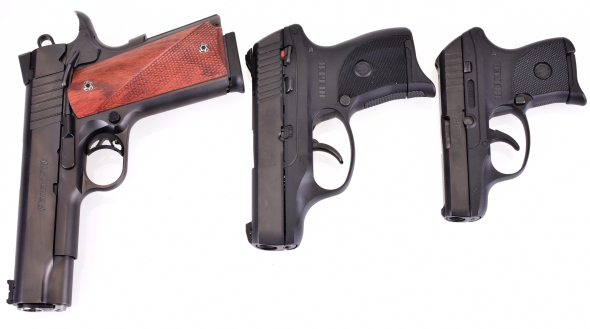
Pictured left to right: Compact R1 1911 Commander, compact Ruger LC380, diminutive Ruger LCP. Compared to what is considered a compact 1911 Commander, the thin slab sided LC380 weighs a full pound and one third less, it is 2 3/4″ shorter in length and 1″ less in height. On the other hand, the increase in the size of the LC380 over the LCP brings features that were omitted from the LCP as an accommodation to its diminutive size and a grip large enough to get some finger purchase. No, you can’t by fingers, just some space to put them.
Left side controls, left, diagonally and upward to right: takedown plate, slide hold open, manual safety.
I think Ruger did a good job of minimizing the presence of a California mandated hammer lock. Some may embrace the mechanism and use it when the pistol is stowed on inactive status. Some many choose to ignore its presence. The key does come in handy for pushing out the disassembly pin.
By staying with the original California design, the LC380CA retains dovetail mounted steel sights. Three dot in this case, but open to other Ruger and third party sights; dot, fiber optic and Tritium night sights.
How many Californians does it take to check a chamber? One, when there is a loaded chamber indicator with bold instructions engraved, trimmed in bright red that pops up when there is a casing in the chamber. Another feature courtesy of the state of California. In other Ruger models, the small port cut into the barrel hood remains and it used as a viewport check for the appearance of a casing in the pistol’s chamber.
Apart, the Ruger LC380CA has few assemblies to deal with on disassembly. The hammer is visible at the rear of the frame, defining it as not a striker. The barrel has a underside camming block which defines it as a tilting barrel design, fired from a locked breech; not a heavier sprung blow back design. This makes for a more robust design when under pressure and it eases dependency on heavy recoil springs to control slide inertia. Even with its dual springs it is an easy racking pistol.
Slim pistol, 0.900″ at the grip. Nice non slip checkering, contoured for a high grip, the hammer is enclosed until the very last bit of travel. Unlike many subcompact pistols, the sights are quite functional and highly visible as a three dot system. The LC380CA is supplied with an extended magazine floor plate installed for increased finger support. However, a standard floorplate is also packed in the box for folks who do not want the extended grip feature.
The power of the pocket pistol
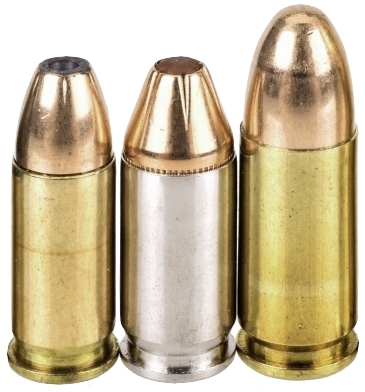 the 380 Automatic is the middle child cartridge of compact pistol cartridges, sandwiched between the 32 Auto and the 9mm Luger. The 32 Automatic has a gross capacity of 9.25 grains of H2O, the 380 Automatic has a gross capacity of 11.5 grains and the 9mm Luger has a gross capacity of 13.8. the SAAMI standard velocity differences are disproportionate to capacity.
the 380 Automatic is the middle child cartridge of compact pistol cartridges, sandwiched between the 32 Auto and the 9mm Luger. The 32 Automatic has a gross capacity of 9.25 grains of H2O, the 380 Automatic has a gross capacity of 11.5 grains and the 9mm Luger has a gross capacity of 13.8. the SAAMI standard velocity differences are disproportionate to capacity.
However, physical size differentials are not proportional to ballistic performance. Where the 32 Automatic and 380 Automatic are relatively low pressure cartridges with, respectively, a 20,500 psi and 21,500 psi SAAMI MAP pressure, the standard 9mm Luger has a 35,000 psi MAP pressure. The SAAMI 9mm Luger +P is rated even higher with a 38,500 psi MAP.
Omitting the 32 Automatic because it does not have a standard bullet weight above 71 grains, or in common with the larger cartridges, the standard for an 88 grain bullet for the 380 Auto is 980 fps, 1,500 fps for the 9mm Luger. At 95 grains, the 380 Auto standard velocity is 910 fps, 1,330 for the 9mm Luger. So an approximately 20% increase in capacity, plus a boost in pressure, gives the 9mm Luger a 53% increase in velocity in the case of the 88 grain bullet and a 46% at 95 grains**.
How about at heavier bullet weights? Good question keyfob308@curious.com. Therein lies a further distinction between 32 Auto, 380 Auto and 9mm Luger pistols. The 32 Auto bullets tops out at 75 grains, the 380 Auto bullet weight tops out at 102 grains and the 9mm Luger tops out at 158 grains for over the counter ammunition.
My point is, related to the Ruger LC380CA, that a 380 Automatic is not the same as a 9mm Luger. However, the 380 Auto will provide close-in self defense, fired from a pistol that is highly concealable, easy to operate and easy to control. If 9mm Luger power is desired, accepting more practice time would be necessary to master control under fire, the 9mm Luger conversion kit would bring that utility.
Ammo I load in my own 380 automatics…
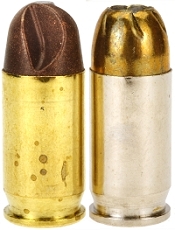 I do not use a 380 Auto for a primary house gun, but I do keep them about as… unanticipated circumstance insurance. I do not carry a 380 Auto in the fall of winter as a primary when there are plenty of ways of carrying a larger, more powerful concealed firearm; a 357 Mag revolver or 45 Auto fills that role. I do carry a subcompact 380 Auto during T shirt weather just about where ever I go and always on road trips.
I do not use a 380 Auto for a primary house gun, but I do keep them about as… unanticipated circumstance insurance. I do not carry a 380 Auto in the fall of winter as a primary when there are plenty of ways of carrying a larger, more powerful concealed firearm; a 357 Mag revolver or 45 Auto fills that role. I do carry a subcompact 380 Auto during T shirt weather just about where ever I go and always on road trips.
There are only two types of 380 Auto ammunition I load into my pistols for self defense, 56 grain ARX and 102 grain Remington Golden Saber. Both penetrate 14″ – 18″ of ballistic gel with the ARX generating a substantial lateral hydraulic load and the Golden Saber double in size, both retaining full weight. The ARX produces above its rated 1,260 fps muzzle velocity at a recorded 1,302. The Golden Saber, rated at 940, clocked 850 fps.
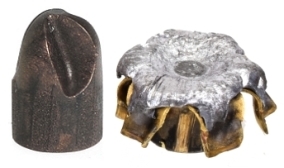 The ARX bullet, far left, is a copper polymer composite that holds up well, but keeps its shape and weight. The Remington Golden Saber expands at 380 Automatic velocity levels, but does not seem to shed weight, where the ARX depends on its high velocity and fluted ogive to generate radial fluid pressure to increase the size of the wound channel.
The ARX bullet, far left, is a copper polymer composite that holds up well, but keeps its shape and weight. The Remington Golden Saber expands at 380 Automatic velocity levels, but does not seem to shed weight, where the ARX depends on its high velocity and fluted ogive to generate radial fluid pressure to increase the size of the wound channel.
Honestly, even ten or fifteen years ago, I would not own a 380 Auto pistol. A long prior experience caused me to look at them mostly as inexpensive, blowback action pistols of questionable reliability, working best with non-expanding full metal jacket ammo and small cavity hollow point ammo that would not reliably expand.
Today there are 21 brands of 380 Automatic ammunition with a combined offering of seventy three types of ammunition from traditional FMJ and HP ammo to the most recent monolith material designs to hard cast bullet +P specialties. I shot the Ruger LC380CA with the two noted rounds, but also with Hornady hollow point and PMC FMJ, eve in mixed ammo type magazines full. No jams, no misfires, no failure to feeds, no signs of early unlocking.
I did not try shooting five shot groups, from horseback, while riding side saddle… as I often do. However, I did shoot these ten yard, three shot groups from a two hand hold, resting on a couple of sandbags. The playing cards are standard size, 2.5″ x 3.5 “. That, to me, is excellent accuracy from a subcompact pistol. And if I stopped being lazy, I could have drifted the rear sight to bring closer to center to optimize for the ammo I shoot.
Conclusion
Definitely a quality subcompact 380 Auto. Easy to conceal, reliable in operation, good defensive firearm, especially where a larger gun might be left home. Best yet, you can live in California and own one.
*”Exempt from California Unsafe Gun Act Roster limitations – The Department of Parks and Recreation. The Department of Alcoholic Beverage Control.The Division of Investigation of the Department of Consumer Affairs. The Department of Motor Vehicles. The Fraud Division of the Department of Insurance. The State Department of State Hospitals. The Department of Fish and Wildlife. The State Department of Developmental Services. The Department of Forestry and Fire Protection. The county probation department. The Los Angeles World Airports, K-12 public school district for use by a school police officer. A municipal water district for use by a park ranger. A county for use by a welfare fraud investigator or inspector. A county for use by the coroner or the deputy coroner. The Supreme Court and the courts of appeal for use by marshals of the Supreme Court and bailiffs of the courts of appeal and coordinators of security for the judicial branch.
A fire department or fire protection agency of a county,city, city and county, district, or the state for use by either of the following. A member of an arson-investigating unit, regularly paid and line 2 employed in that capacity pursuant to Section 830.37. A member other than a member of an arson-investigating line 4 unit, regularly paid and employed in that capacity. The University of California Police Department, or the California State University Police Departments. A California Community College police department. A harbor or port district or other entity employing peace officers. The San Diego Unified Port District Harbor Police, and the Harbor Department of the City of Los Angeles.
The California Horse Racing Board. The State Department of Health Care Services. The State Department of Public Health. The State Department of Social Services. The Department of Toxic Substances Control. The Office of Statewide Health Planning and Development. The Public Employees’ Retirement System. The Department of housing and Community Development. Investigators of the Department of Business Oversight. The Chief and coordinators of the Law Enforcement Branch of the Office of Emergency Services. Lottery security personnel assigned to the California State Lottery Commission. The Franchise Tax Board.
**The SAAMI standard barrel length for the 380 Automatic is 3.75″ and 4.00″ for the 9mm Luger.

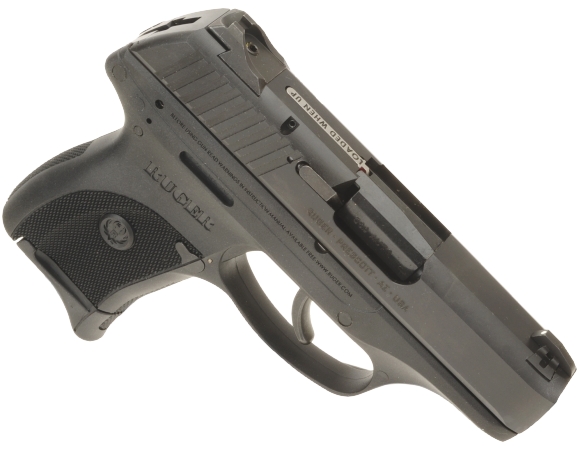
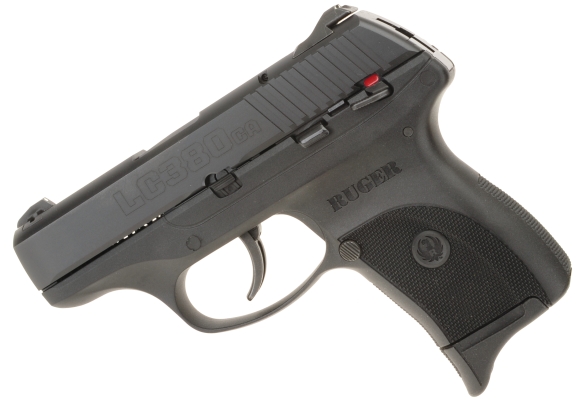
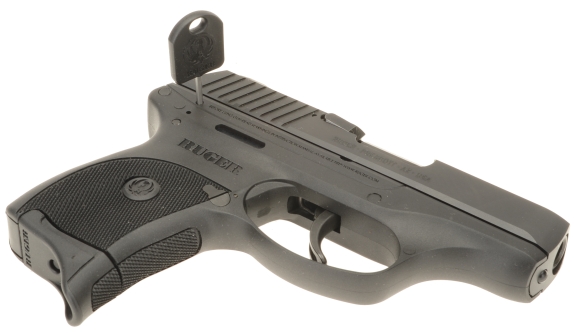


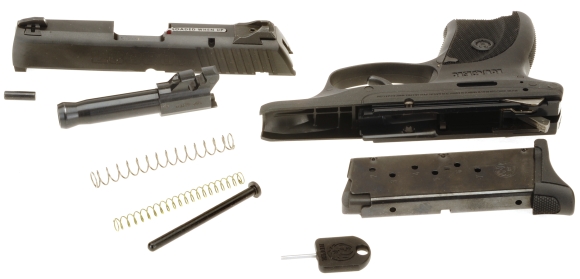

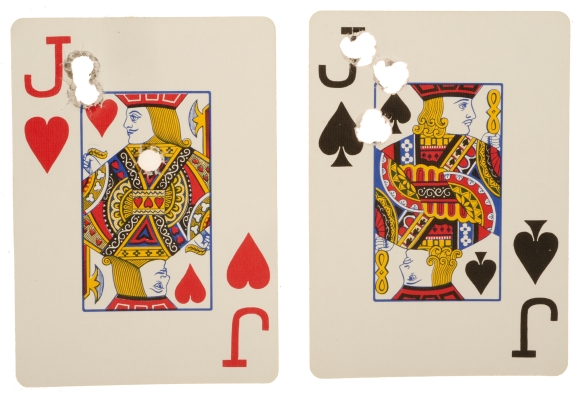
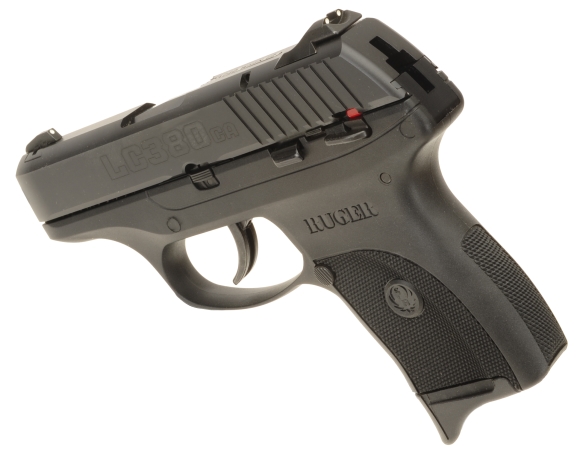
Email Notification